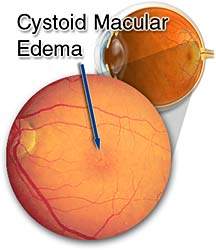Eye Care > Diseases of the Eye > Cystoid Macular Oedema
Cystoid macular oedema (CME), or swelling of the macula, typically occurs as a result of disease, injury or more rarely, eye surgery. Fluid collects within the layers of the macula, causing blurred, distorted central vision. CME rarely causes a permanent loss of vision, but the recovery is often a slow, gradual process. The majority of patients recover in 2 to 15 months.

In this retinal photograph, the swelling is the yellowish spots (arrow) in the macula.
It is very difficult to detect CME during a routine examination. A diagnosis is often based on the patient’s symptoms and a special dye test called a fluorescein angiogram (FA).
The first line of treatment for CME is usually anti-inflammatory drops. In certain cases, medication is injected near the back of the eye for a more concentrated effect. Oral medications are sometimes prescribed to reduce the swelling.
Illustrations by Mark Erickson
With acknowledgement to St. Lukes Eye Hospital.
| Cookie | Duration | Description |
|---|---|---|
| cookielawinfo-checkbox-analytics | 11 months | This cookie is set by GDPR Cookie Consent plugin. The cookie is used to store the user consent for the cookies in the category "Analytics". |
| cookielawinfo-checkbox-functional | 11 months | The cookie is set by GDPR cookie consent to record the user consent for the cookies in the category "Functional". |
| cookielawinfo-checkbox-necessary | 11 months | This cookie is set by GDPR Cookie Consent plugin. The cookies is used to store the user consent for the cookies in the category "Necessary". |
| cookielawinfo-checkbox-others | 11 months | This cookie is set by GDPR Cookie Consent plugin. The cookie is used to store the user consent for the cookies in the category "Other. |
| cookielawinfo-checkbox-performance | 11 months | This cookie is set by GDPR Cookie Consent plugin. The cookie is used to store the user consent for the cookies in the category "Performance". |
| viewed_cookie_policy | 11 months | The cookie is set by the GDPR Cookie Consent plugin and is used to store whether or not user has consented to the use of cookies. It does not store any personal data. |